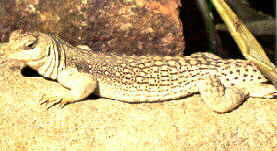

The Desert Iguana is between 10 and 16 inches long. It has a long tail and relatively round body. The desert iguana is light-colored: it ranges from a light-brown around its head to a grayish-white along the rest of its body. It also has patterns of darker brown stripes along its side and spots on its long tail. The head of the desert iguana is short and the scales along its back are slightly larger than in other areas.
As the name suggests, the desert iguana is found in dry, arid areas or rocky streambeds. They are common in the southwestern USA and northern Mexico. These iguanas shelter themselves in the rocks and scrub bushes of the desert to stay cool, but they can tolerate heat as high as 115 degrees F. Desert iguanas also use the burrows and holes made by other animals as protection from enemies, sometimes making a complex system of tunnels through the sand. The desert iguana is mainly a plant eater, feeding off flowers from the creosote bush as well as fruits, leaves, and seeds of other desert plants. It will also eat small insects or rodents if it can find them.
The desert iguana hibernates for the winter and comes out by mid-March. At this time, males will start looking for mates. By mid-May, mating takes place. Females lay between 2 and 10 eggs during May and June after digging a hole or trench for them. She covers the eggs with sandy soil, but does not guard or tend them afterwards. Eggs hatch by July or August; the young desert iguanas climb into scrub bushes and eat any insects they can catch.